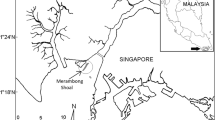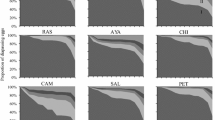Synopsis
Survival of dace eggs in a chalkstream was 8.6 to 21.8% from spawning to hatching. The proportion of dead eggs in samples rose from 4.9% at the end of spawning to 59% after 13 days. The combined number of dead eggs, live eggs and the empty shells of eggs after hatching also began a steady decline soon after the end of spawning. Egg drift was estimated to be 2.0% of the initial egg population. Laboratory studies and field population estimates indicated that macroinvertebrates were capable of eating large numbers of dead eggs but much smaller numbers of live ones. A large part of the fall in egg numbers was accounted for by egg decomposition. There was a close relationship between the percentage of surviving eggs and substrate composition with poor survival in areas of high silt and low gravel content.
Similar content being viewed by others
References cited
Carbine, W. F. 1944. Egg production of the northern pike,Esox lucius L., and the percentage survival of eggs and young on the spawning grounds. Pap. Mich. Acad. Sci., Arts and Lett. 29 (1943): 123–137.
Clady, M. D. 1975. Early survival and recruitment of smallmouth bass in northern Michigan. J. Wildl. Manage. 39: 194–200.
Claire, E. W. & R. W. Phillips. 1968. The stoneflyAcroneuria pacifica as a potential predator on salmonid embryos. Trans. Amer. Fish. Soc. 97: 50–52.
Ellis, R. J. 1970.Alloperla stonefly nymphs: Predators or scavengers on salmon eggs and alevins. Trans. Amer. Fish. Soc. 99: 677–683.
Fox, P. J. 1978. Caddis larvae (Trichoptera) as predators of fish eggs. Freshwat. Biol. 8: 343–345.
Hassler, T. J. 1970. Environmental influence on early development and year-class strength of northern pike in Lakes Oahe and Sharpe, South Dakota. Trans. Amer. Fish. Soc. 99: 369–375.
Hiley, P. D., J. F. Wright & A. D. Berrie. In press. A new sampler for stream benthos, epiphytic macrofauna and aquatic macrophytes. Freshwat. Biol.
Kennedy, M. 1969. Spawning and early development of the dace (Leuciscus leuciscus L.). J. Fish. Biol. 1: 249–259.
Mathews, C. P. 1971. Contribution of young fish to total production of fish in the River Thames near Reading. J. Fish. Biol. 3: 157–180.
May, R.C. 1974. Larval mortality in marine fishes and the critical period concept. 3–13. In: J.H.S. Blaxter (ed.) The early life history of fish, Springer-Verlag, New York.
Mills, C. A. 1980. Spawning and rearing eggs of the dace,Leuciscus leuciscus (L.). Fish. Mgmt. 11: 67–72.
Newburg, H. J. 1974. Planarians as a mortality factor on spawned fish eggs. Prog. Fish. Cult. 36: 227–230.
Nicola, S. J. 1968. Scavenging byAlloperla (Plecoptera: Chloroperlidae) nymphs on dead pink (Oncorhynchus gorbuscha) and chum (O. keta) salmon embryos. Can. J. Zool. 46: 787–796.
Oseid, D. M. 1977. Control of fungus growth on fish eggs byAsellus militaris andGammarus pseudolimnaeus. Trans. Amer. Fish. Soc. 106: 192–195.
Peterka, J. J. & J. S. Kent. 1976. Dissolved oxygen, temperature, survival of young at fish spawning sites. Ecol. Res. Ser. U.S. Environ. Prot. Ag. EPA-600/3-76-113, pp. 35.
Scorgie, H. R. A. 1974. Studies on the food of invertebrates in the River Lambourn with particular reference to the role of detritus in the trophic economy of the community. PhD Dissertation, University of Reading, England. 139 pp.
Siefert, R. E., A. R. Carlson & L. J. Herman. 1974. Effects of reduced oxygen concentrations on the early life stages of mountain whitefish, smallmouth bass and white bass. Prog. Fish. Cult. 36: 186–190.
Siefert, R. E., W. A. Spoor & R. F. Syrett. 1973. Effects of reduced oxygen concentrations on northern pike (Esox lucius) embryos and larvae. J. Fish. Res. Board Can. 30: 849–852.
Vladimirov, V. I. 1970. Ontogenetic qualitative differences as one factor in the dynamics of a fish population (research tasks). Gidrobiol. 6: 7–18.
Welton, J. S. 1977. Detritus dynamics in the Tadnol Brook related to the ecology of a detritus consumer —Gammarus pules (L.). PhD Dissertation, University of Reading, England. 309 pp.
Welton, J. S. 1979. Life-history and production of the amphipodGammarus pulex in a Dorset chalkstream. Freshwat. Biol. 9: 263–275.
Wilkinson, D. R. & J. W. Jones. 1977. The fecundity of daceLeuciscus leuciscus (L.) in Emral Brook, Clwyd, North Wales. Freshwat. Biol. 7: 135–145.
Żuromska, H. 1967a. Mortality estimation of roach (Rutilus rutilus L.) eggs and larvae on lacustrine spawning grounds. Roczniki Nauk Roln. 90: 539–556.
Żuromska, H. 1967b. Some causes of mortality of roach (Rutilus rutilus L.) eggs and larvae on lake spawning grounds. Roczniki Nauk Roln. 90: 557–579.
Author information
Authors and Affiliations
Rights and permissions
About this article
Cite this article
Mills, C.A. Egg population dynamics of naturally spawning dace,Leuciscus leuciscus (L.). Environ Biol Fish 6, 151–158 (1981). https://doi.org/10.1007/BF00002778
Received:
Accepted:
Issue Date:
DOI: https://doi.org/10.1007/BF00002778




